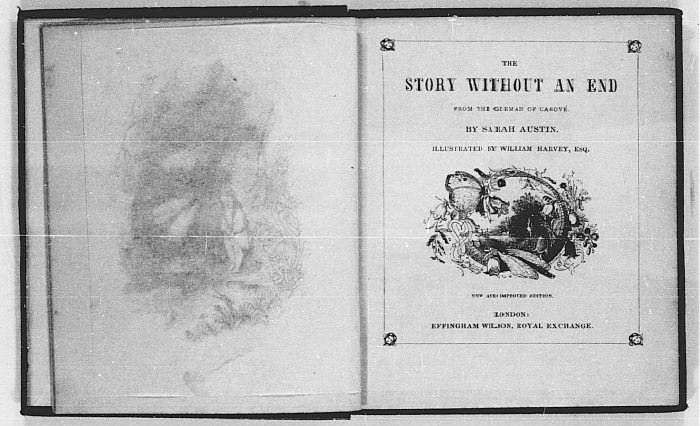Stories Before 1850. 0057: Sarah Austin, The Story Without An End
| Author: |
Austin, Sarah |
| Title: |
The story without an end. From the German of Carové. By Sarah Austin. Illustrated by William Harvey, Esq. New and improved edition |
| Cat. Number: |
0057 |
| Date: |
No date but c.1834-1850 |
| 1st Edition: |
1834 |
| Pub. Place: |
London |
| Publisher: |
Effingham Wilson, Royal Exchange |
| Price: |
2s 6d (from advertisement at end of volume) |
| Pages: |
1 vol., 130pp. |
| Size: |
13.5 x 10 cm |
| Illustrations: |
17 engraved vignettes and much additional decoration |
| Note: |
Catalogue of books (i.e. four pages of advertisements) at end of volume |
Images of all pages of this book

Introductory essay
Sarah Austin (1793-1867) was a noted translator of German texts. Born in Britain, since 1827 she and her husband had been living in Germany (see D.N.B.. They were to return in 1848. The Story Without an End, translated from Friedrich Wilhelm Carové's Das Mhrchen ohne Ende, was one of her first efforts, appearing in 1834. It was republished on numerous occasions throughout the nineteenth, and into the twentieth, century.
The tale itself is in the same vein as William Roscoe's Butterfly's Ball (1806) and its many derivatives, but, at times, a more symbolic meaning seems also to be present. A boy lives alone in a hut in the middle of a forest. He invites insects to his cave for breakfast, and they bring him all the good things of the forest. He talks to them all finding that they all have different characters and personalities. One day he goes off with his favourite, the dragon-fly, but they get lost. The spiders knit him a cobweb bed, the fireflies light his way, and his other insect friends come to his aid in various other ways. Eventually, after an adventure with a will-o-the-wisp, he finds his way back home. The narrative is twee, but not overtly pious. It is hardly educational in any straightforward sense except in so far as it identifies and characterises various inhabitants of the forest. The unnamed hero, the Child, is presented as entirely innocent, and sometimes seems rather Christ-like, but this is not to liken The Story Without an End to those animal stories of the early nineteenth century which simply cast animals as the characters in what were otherwise conventional moral tales. On the other hand, the tale of the Will-o-the-wisp, who had once been a deceitful child itself, does retail a clear moral lesson, albeit in a rather ethereal form.



